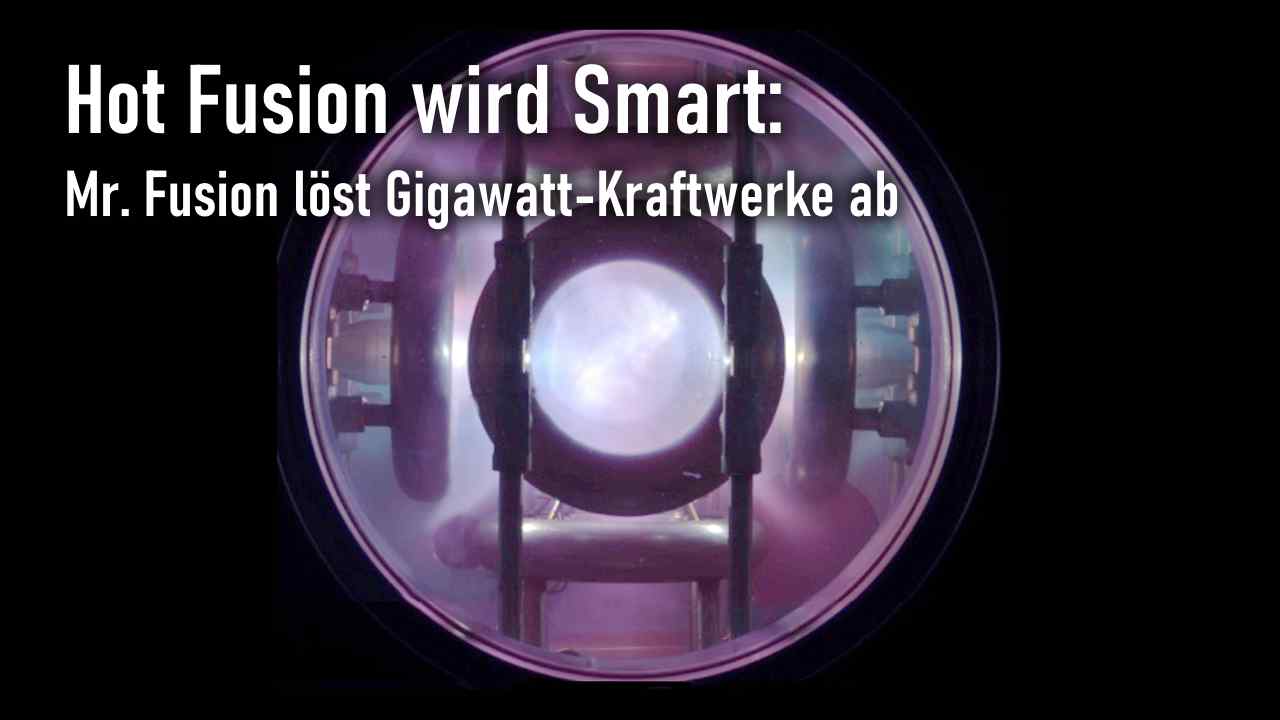
2101 Smart Fusion

Die Geschichte der Kernfusion hat Höhen und Tiefen, vor allem aber Längen. Neue physikalische Ansätze führen schneller zum Ziel als die großen und teuren Tokamaks. Dezentralisierte Fusionsanlagen lösen Gigawatt-Kraftwerke ab. Hot Fusion wird smart.
Viele Jahrzehnte wird die Fusionsforschung durch den Toroid-Ansatz dominiert. Mit Tokamak und Stellarator gibt es schnelle Anfangserfolge. Aber spätestens in den 80er Jahren des 20. Jahrhunderts wird klar, dass die frühen Versprechen nicht eingehalten werden können. Trotzdem wird weiterhin sehr viel Geld in riesige Fusionsexperimente investiert.
Während sich die Torus-orientierte Forschung in die Länge zieht und Generationen von Plasmaphysikern beschäftigt, entsteht in den 2000er Jahren eine Welle von neuen Ansätzen zur Kernfusion. Die klassische Tokamakforschung versucht, immer heißere und längere Plasmazustände zu schaffen, um wenigstens einige Teilchen zur Fusion zu bringen. Das Prinzip besteht darin, ein Plasma durch Druck und zusätzliche Heizung viele Millionen Grad heiß zu machen. Deshalb wird sie Hot Fusion genannt.
Im Gegensatz dazu konzentrieren sich die neuen Smart Fusion genannten Ansätze darauf, dem Fusionsbrennstoff genau die richtige Energie mit auf den Weg zu geben und den Großteil des Plasmas für Fusion zu aktivieren. Auch Smart Fusion Technologien verwenden heißes Plasma. Manche aber in Form von schnellen Ionen bei denen die Teilchengeschwindigkeit nicht durch Heizung, sondern durch Hochspannung erreicht wird. Das ist physikalisch günstiger, deshalb "smart".
Schnell gibt es mehrere Smart Fusion Methoden mit ganz unterschiedlichen Charakteristiken. Allen gemeinsam ist aber, dass sie im Gegensatz zum klassischen Tokamak:
- für neutronenfreie Fusionsprozesse geeignet sind und fast keine Radioaktivität erzeugen,
- direkt elektrische Energie liefern, ohne den Umweg über eine Dampfturbine,
- kompakter, günstiger und für eine dezentrale Energieversorgung geeignet sind.
Smart Fusion Forschung findet für einige Jahrzehnte im Schatten der Tokamakforschung statt. Die Hot Fusion Flaggschiff-Projekte mobilisieren 100-mal mehr finanzielle Mittel als Smart Fusion Projekte. Trotzdem übertreffen die Kennzahlen von Smart Fusion bald die von Hot Fusion. Das liegt nicht nur an den langen Bauzeiten für große Tokamaks, sondern auch an den günstigeren physikalischen Ausgangsbedingungen.
Mitte der 20er Jahre erreichen mehrere Smart Fusion Projekte den Break-Even für den Fusionsprozess in Testkonfigurationen. Das sind noch lang keine Kraftwerke. Aber der Weg ist klar und das Ziel schon nah. Zehn Jahre später erreichen einige Forschungsreaktoren den Break-Even mit kompletten Systemen.
Nach diesen Erfolgen tritt Smart Fusion aus dem Schatten der Tokamaks. Um 2035 entsteht eine Welle von Fusions-Startups durch Ausgründungen von wissenschaftlichen Instituten und Tochtergesellschaften von Energiekonzernen. Große Investitionen fließen in Smart Fusion Projekte. Die Planung für den Tokamak-Reaktor DEMO als ITER-Nachfolger wird gestoppt.
Die Welt hungert nach Energie. Aus den Forschungsreaktoren werden in relativ kurzer Zeit Demonstratoren für kommerzielle Reaktoren entwickelt. Gegen 2040 gehen mehrere Reaktoren mit Leistungen von 50 bis 200 Megawatt in Betrieb.
Die meisten Reaktoren verwenden den pB11-Prozess mit Protonen und Bor-11 Ionen, der keine Neutronen erzeugt und damit kaum radioaktive Strahlung produziert. Die Fusionsprodukte sind Alphateilchen, geladene Heliumkerne mit hoher Energie. Sie können direkt in Strom umgewandelt werden durch inverse Zyklotrons und Linacs. Damit entfällt der Zwischenschritt über Wärmetauscher und Dampfturbine. Der Wirkungsgrad der Stromumwandlung ist 80%.
Die wichtigsten Technologien sind:
- Elektrostatischer Einschluss mit virtueller Anode (IEC)
- Selbstfokussierender Einschluss unter Ausnutzung natürlicher Plasmainstabilitäten (DPF)
- Kollidierende Plasmaringe in zylindrischem Einschluss mit umgekehrter Feldkonfiguration (FRC)
- Laserbeschleuniger für Protonen mit Borplasma-Target (LAF)
Mitte des Jahrhunderts gehen die ersten großen kommerziellen Reaktoren mit einer Leistung von 500 MW in den Regelbetrieb. Andere Technologien ermöglichen auch Kraftwerke mit 5 MW. Zwischen 2050 und 2055 laufen die meisten Patente für die technologischen Grundlagen von Fusionsreaktoren aus. Das ermöglicht vielen neuen Anbietern den Markteintritt. Es entsteht eine lebendige Dienstleistungsinfrastruktur für Wartung, Betrieb, Sicherheitsüberwachung und Brennmittel. Schon 15 Jahre später, um 2065 liefern kommerzielle Fusionskraftwerke die Hälfte der Grundlast.
Die Versorgungsstruktur ist regional sehr unterschiedlich. In manche Regionen gibt es Kraftwerkszentren, die die Energieerzeugung bündeln und die bestehende Netzinfrastruktur weiterverwenden. Andere Regionen und einzelne Städte verlassen sich auf kleinere lokale Kraftwerksblöcke im 50-100 MW Bereich. Dort werden die alten Überlandleitungen sogar abgebaut.
Beim Ausfall der Netze ab 2070 sind Fusionskraftwerke betroffen wie alle Kraftwerke. Bis auf wenige Ausnahmen sind Kraftwerkssteuerungen auf Informations- und Stromnetze angewiesen. Im Gegensatz zu den meisten anderen Kraftwerkstypen, von Erneuerbaren über Verbrennung- bis zu Fissionskraftwerken, brauchen Fusionskraftwerke auch eine starke Stromquelle zum Betrieb. Der Fusionsprozess wird durch Ionenheizung, Magnetfelder, Laser, gekühlte Supraleiter und Starkstromentladungen am Leben gehalten. All diese Techniken brauchen Stromquellen. Fusionskraftwerke sind gewissermaßen Energieverstärker. Während große Windkraftanlagen ohne eigene Stromversorgung zehn Megawatt produzieren können, braucht ein 10 MW Fusionsreaktor selbst fast ein Megawatt Strom zum Betrieb. In der Krisensituation ist die Umrüstung von Kraftwerken auf autarken Betrieb besonders schwierig. Bei Fusionsanlagen kommt noch das Problem des Betriebsstroms hinzu.
Es dauert viele Jahre bis wieder Strom aus Fusionskraftwerken kommt. Fusionskraftwerke sind sehr neu und deshalb noch mehr von Informationsnetzen abhängig als ältere Kraftwerkstypen. Die Steuersoftware muss umgeschrieben werden. Das geht nur mit Strom und moderner Ausrüstung. Dann müssen Schäden behoben werden, die während der Krise und der langen Standzeit aufgetreten sind. Die Ersatzteilbeschaffung ist sehr schwierig. Es geht nicht nur um elektronische Bauteile, Turbinen, Getriebe oder Leitungen, sondern je nach Fusionstechnologie auch um Supraleiter, Vakuumpumpen, Halbleiterlaser, nanometergenaue Hochspannungsanoden aus seltenen Erden und viele andere Hightech-Komponenten.
Zu Beginn der Krise war schon 60% der Stromversorgung auf Fusion umgestellt. Das war aber regional sehr unterschiedlich. In Europa hatte man traditionell viel Wert gelegt auf regenerative Energien und bei Fusion auch auf Dezentralisierung. Dort herrschen kleinere Anlagen vor, die weniger Betriebsstrom brauchen. Dieser kommt irgendwann wieder aus den anderen reaktivierten Kraftwerken und damit können auch die Fusionskraftwerke wieder anlaufen. In den später industrialisierten Regionen Afrikas und Asiens dominieren Großkraftwerke und Kraftwerkskomplexe. Die Wiederinbetriebnahme dauert teilweise bis zu 40 Jahre.
Zu Beginn des 22. Jahrhunderts kämpfen manche Länder und Regionen noch um die Wiederherstellung ihrer Hightech-Infrastruktur. Andere haben schon wieder Ressourcen, um die Fusionstechnologie weiterzuentwickeln. Nach den Erfahrungen der Krise konzentriert sich die Forschung auf kleinere Anlagen und Dezentralisierung. Kurz nach 2100 werden 100 kW Fusionsbrenner marktfähig. Sie sind für die Versorgung einzelner Häuser geeignet. Ein Mikro-Kraftwerk hat die Größe eines Kleintransporters. Damit hat es eine geringere Energiedichte als ein Verbrennungsmotor oder ein alter Gasbrenner. Aber im Gegensatz zu fossilen Kraftwerken läuft ein Fusionsgenerator jahrelang mit einer Wasserstoff-Bor11-Kartusche und erzeugt nur ungefährliches Helium-Gas als Abfallprodukt.
Als um 2120 die Wirtschaftsleistung der Welt wieder das Vorkrisenniveau erreicht, liefert Smart Fusion 80% des Stroms. Wirtschaft und Wohlstand wachsen weiter. Der Energiebedarf verdoppelt sich alle 15 Jahre. Große IEC-Anlagen im Gigawatt Bereich werden ergänzt durch 100 kW DPFs. Strom und Energie sind kein Flaschenhals mehr für Wachstum und Wohlstand.
Neue Beiträge
2158 Space Patrol
2222 Weltraumpiraten
2326 Kein interplanetarer Krieg
3050 Königliche Garde
3090 Solo Ehre
2234 Am Ende des Orbits
2248 Gemini-Katastrophe
2366 Orbitale Ökonomie
2312 Kaio-Artefakt
3361 Erste Menschheit
2333 Metrische Impulsverstärkung
2337 Verschwörung im Orbit
2247 Quantensprung
2284 Trennung der Erde
2321 Isolation der Erde
2205 Unternehmensnationen
2192 Antiexpansionistischer Terror
2179 Private Asteroidenbasis
2231 Vereinte Planeten
2291 Verbotene Forschung
Die Besten
(20 von 75)
2231 Vereinte Planeten
2321 Isolation der Erde
2333 Metrische Impulsverstärkung
2412 Pontos Mission
2445 Scum-Festival
2478 Razzia im Asteroidengürtel
2518 Geheime interstellare Mission
2532 Panik im Sonnensystem
2535 Tragödie von Cobol
2544 Nachricht des Jahrhunderts
2557 Invasion aus dem Orbit
2560 Fakultät für Exotechnologie
2668 Ultrametalle
2776 Höhlensysteme
2956 Chaosmanager
3116 Shackleton-Aufstand
3191 Umzug nach Cobol
3225 Flux-Manifest
3245 Sterge-Blockade
3361 Erste Menschheit
 2094
Der Crash
2094
Der Crash

 2115
Neuroimplantate
2115
Neuroimplantate